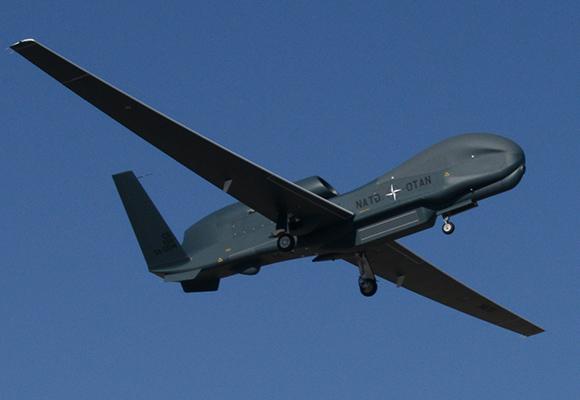NATO's Alliance Ground Surveillance program, which is based on the APR platform Global Hawk of Northrop Grumman, has made an important step with the first flight of the new system. The long-range surveillance aircraft took off the December 19 from Palmdale, California, on an 2,5-hour mission. It's how much they communicate from Northrop.
The aircraft successfully completed a series of tests flying to 40.000 feet before landing at the Edwards Air Force Base in California. "The flight of the new AGS system has shown the goodness of the program, six months after its presentation. The Alliance Ground Surveillance will give NATO enhanced ISR (intelligence, surveillance and reconnaissance) capabilities ".
The main base of NATO's Airborne ground surveillance will be Sigonella, in Sicily. Just on the Italian base, five UAV aerial platforms will be deployed, supported by two further mobile land bases. The latter will guarantee greater connectivity and data transmission speed. Within the 2016 all the aerial platforms of the AGS program will be located in Sigonella. The initial operational capacity is scheduled for the 2017.
Sigonella the role of Italy
Sigonella, in Sicily, is the heart ofAlliance Ground Surveillance, probably the most important NATO asset for intelligence, surveillance and reconnaissance missions (Joint Intelligence, Surveillance and Reconnaissance - JISR). The Sicilian base will reach the Initial Operational Capacity in the 2017 with Full Operational Capability in 2018.
The AGS consists of two segments: the Aircraft based on the Hale (High-Altitude Long-Endurance Unmanned Aircraft System) Globak Hawk RQ-4 Block 40 and that on the ground to which it is charged both the ability to control the mission and the analysis, distribution and storage of the data. Sigonella hosts either the MOS or Mission Operation Support that l 'Air Vehicle Missions Command and Control (AVMC2), including the entire logistics system.
AGS's first contractor is Northrop Grumman, who signed 2012's 1,7 deal in May with a $ XNUMX contract for a fleet of five Global Hawk with MP-RTIP radar. The primary industrial team includes EADS Deutschland GmbH (Cassidian), Selex Galileo and Kongsberg, ICZ, AS, Retia, AS, Aktors OÜ, Komerccentrs DATA grupa, Elsis LTD., Konstrukta-Defense, AS, COMTRADE DOO, Bianor, Technological, ZTA AD, SELEX ELSAG, Elettra Communications, UTI Systems and SES. The 15 participating nations are Bulgaria, the Czech Republic, Denmark, Estonia, Germany, Italy, Latvia, Lithuania, Luxembourg, Norway, Poland, Romania, Slovakia, Slovenia and the United States. All 28 nations of the alliance will support the long-term program.
The air segment of the AGS program will be based on the RQ-4 drone, capable of flying at maximum altitudes of 60.000 feet for more than 32 hours at speeds approaching the 340 nodes, well above the air space occupied by commercial traffic. The RQ-4 can operate at two thousand nautical miles from its main base of operations. It is considered the best existing robot platform for intelligence, surveillance and reconnaissance missions able to monitor one hundred thousand square kilometers of land in a single day. The high-definition synthetic aperture radar MP-RTIP, is able to detect and track every object on the ground and low-altitude cruise missiles. In terms of interoperability with NATO systems, one can not fail to mention the MUOS of the US NAVY, a new generation narrow-band tactical system of satellite communication between the US forces on the move.
 The MUOS was designed to provide the military with greater communication capabilities than existing systems. The four satellites (plus one in reserve) MUOS in geostationary orbit (in the photo the launch of the fourth), are equipped with Code Division Multiple Access wide-bandwidth (WCDMA), with a 16 transmission rate times greater than the current satellite system Ultra High Frequency (UHF). Each MUOS satellite is fully compatible with the previous frequencies used to ensure a smooth transition to WCDMA technology by retrieving the UFO system (UHF Follow-On).
The MUOS was designed to provide the military with greater communication capabilities than existing systems. The four satellites (plus one in reserve) MUOS in geostationary orbit (in the photo the launch of the fourth), are equipped with Code Division Multiple Access wide-bandwidth (WCDMA), with a 16 transmission rate times greater than the current satellite system Ultra High Frequency (UHF). Each MUOS satellite is fully compatible with the previous frequencies used to ensure a smooth transition to WCDMA technology by retrieving the UFO system (UHF Follow-On).
The four ground stations are associated with a satellite. The former is located at the Australian Defense Satellite Communications Station, in Kojarena, about 30 km east of Geraldto. The second one at Niscemi, at 60 km from Sigonella's Naval Air Station. The third in Southeast Virginia and the fourth in Hawaii.
It would be fair to say that Sigonella, in a few weeks, will become one of the main bases of the US Navy and certainly the most important of NATO.
(photo: Northrop Grumman / United Launch Alliance)












